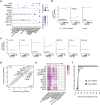Genetic determinants of host- and virus-derived insertions for hepatitis E virus replication
- PMID: 38844458
- PMCID: PMC11156872
- DOI: 10.1038/s41467-024-49219-8
Genetic determinants of host- and virus-derived insertions for hepatitis E virus replication
Abstract
Hepatitis E virus (HEV) is a long-neglected RNA virus and the major causative agent of acute viral hepatitis in humans. Recent data suggest that HEV has a very heterogeneous hypervariable region (HVR), which can tolerate major genomic rearrangements. In this study, we identify insertions of previously undescribed sequence snippets in serum samples of a ribavirin treatment failure patient. These insertions increase viral replication while not affecting sensitivity towards ribavirin in a subgenomic replicon assay. All insertions contain a predicted nuclear localization sequence and alanine scanning mutagenesis of lysine residues in the HVR influences viral replication. Sequential replacement of lysine residues additionally alters intracellular localization in a fluorescence dye-coupled construct. Furthermore, distinct sequence patterns outside the HVR are identified as viral determinants that recapitulate the enhancing effect. In conclusion, patient-derived insertions can increase HEV replication and synergistically acting viral determinants in and outside the HVR are described. These results will help to understand the underlying principles of viral adaptation by viral- and host-sequence snatching during the clinical course of infection.
© 2024. The Author(s).
Conflict of interest statement
The authors declare no competing interests.
Figures







References
-
- World Health Organization (WHO), Hepatitis E: Fact sheet. Available at https://www.who.int/news-room/fact-sheets/detail/hepatitis-e 2021
MeSH terms
Substances
Grants and funding
- 448974291/Deutsche Forschungsgemeinschaft (German Research Foundation)
- 01KI2106/Bundesministerium für Bildung und Forschung (Federal Ministry of Education and Research)
- R21 AI151736/AI/NIAID NIH HHS/United States
- INST 213/840-1 FUGG/Deutsche Forschungsgemeinschaft (German Research Foundation)
- ZMVI1-2518FSB705/Bundesministerium für Gesundheit (Federal Ministry of Health, Germany)
- 01EK2106A/Bundesministerium für Bildung und Forschung (Federal Ministry of Education and Research)
- TTU 05.823_00/Deutsches Zentrum für Infektionsforschung (German Center for Infection Research)
- 510558817/Deutsche Forschungsgemeinschaft (German Research Foundation)
- R01 AI107301/AI/NIAID NIH HHS/United States
LinkOut - more resources
Full Text Sources

